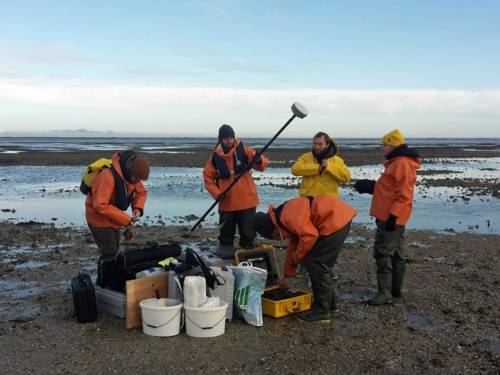Oyster reefs and mussel beds stabilise the Wadden Sea
A study led by Leibniz University Hannover shows that the vertical sediment growth of local mudflats will be able to withstand sea level rise in the future.
Sea levels are rising globally. Depending on climate-damaging emissions, they could rise by 80 centimetres or more by the end of this century, according to projections by the Intergovernmental Panel on Climate Change (IPCC). At the same time, sea temperatures have risen, facilitating the invasion of the non-native Pacific oyster in the Wadden Sea more than two decades ago. It is displacing the native mussel as the dominant species and transforming former mussel beds into extremely rough oyster reefs. The oyster reefs are spreading incessantly across the area, changing both the ecosystem and the wave and current behaviour. However, this could also help mudflats to literally avoid drowning as the average sea level rises. This connection has been demonstrated for the first time in a study quantifying sediment growth in the Wadden Sea in the vicinity of oyster reefs and mussel beds. It was led by Leibniz University Hannover.
BIVA-WATT research project
The underlying BIVA-WATT research project investigates the role of oyster reefs and mussel beds as biogenic structures in the German Wadden Sea. For the first time, scientists have carried out large-scale measurements of sedimentation in and around these structures and evaluated the data collected. In addition to the Ludwig Franzius Institute for Hydraulic Engineering, Estuarine and Coastal Engineering at Leibniz University Hannover, the Technical University of Braunschweig and Senckenberg am Meer were also involved. The results have now been published in Scientific Reports by NATURE-Springer.
Tidal flats are growing faster than sea levels are rising
The research team studied two oyster reefs and a mussel bed at three different locations over a period of two years. The result: the oyster reefs and mussel beds promote vertical sediment growth at an annual rate of up to 3.9 centimetres. This increases the local sandy environment of the oyster- and mussel-covered mudflats. The average growth of mudflats observed to date is 0.9 centimetres per year, while sea levels are currently rising between 0.4 and 0.7 centimetres. According to IPCC projections, this rise will accelerate sharply if climate protection targets are not met. Valuable mudflats, which protect the coasts and contribute to the preservation of the marine environment, would literally drown in these scenarios, as sea levels are rising faster than the mudflats are growing naturally. ‘The effect of quantified sediment growth by oyster reefs and mussel beds demonstrated in the study can not only contribute to the protection of local coastlines, but also support the existence of the Wadden Sea ecosystem,’ summarises the lead author of the publication and doctoral student Tom K. Hoffmann from the Ludwig Franzius Institute.
‘The study highlights the necessity and success of interdisciplinary approaches in coastal research in order to better understand the complex interactions between biological and geomorphological processes,’ says Prof. Dr.-Ing. Torsten Schlurmann, Director of the Ludwig Franzius Institute. The data evaluated was collected in the joint project BIVA-WATT, which was funded by the Federal Ministry of Education and Research with more than €800,000 from 2019 to 2022.
(Published: 10 June 2025)

